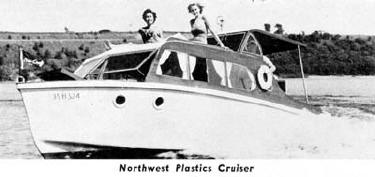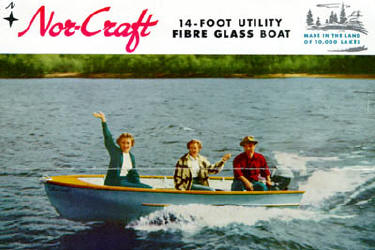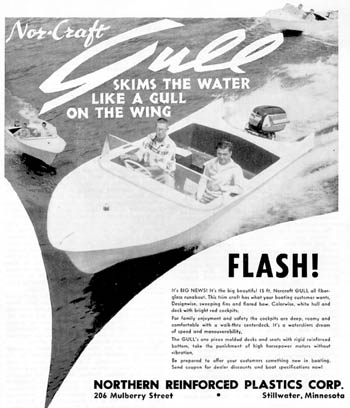By Lee Wangstad
It was a rather strange little boat, caught in the corner of my eye as I headed south out of Nisswa. In the brief instant that it captured my attention, it appeared to be a small lapstrake runabout with its white hull and brightly varnished decks. Of course, by the time this image registered in my mind I was already in the process of turning myself around and heading back to get a closer look.
 It had a wood deck alright, but the hull was fiberglass. It wasn’t a lapstrake after all, but a smooth hull with wood spray rails and wood seats. On the rear quarter of the hull was the name: Nor-Craft. It was parked out front of Nisswa Marine, Classic Boat Division. In talking with Harold Thompson, resident master boat carpenter and restorer, he admitted that he didn’t know a whole lot about it, other than the owners information. It was in the shop for refinishing of the decks, and had just been completed. I told him that
It had a wood deck alright, but the hull was fiberglass. It wasn’t a lapstrake after all, but a smooth hull with wood spray rails and wood seats. On the rear quarter of the hull was the name: Nor-Craft. It was parked out front of Nisswa Marine, Classic Boat Division. In talking with Harold Thompson, resident master boat carpenter and restorer, he admitted that he didn’t know a whole lot about it, other than the owners information. It was in the shop for refinishing of the decks, and had just been completed. I told him that
I would see if I had anything on this one and get back to him.
Looking through my files, I did have one piece of literature from the mid-fifties. The boats were built by the Marine Division of Northwest Plastics, Inc. located on Plato Boulevard in St. Paul. The literature showed a 14′ fishing boat complete with wood gunnels and a small wood deck over the bow. It was also offered as a kit. Digging deeper, I scanned my periodicals for more information. I found an advertisement in the January 15, 1954 issue of The Boating Industry with a similar picture and listing a 14′ utility, a 17′ runabout, and a 20′ cruiser that would be available on June 1st of that year. The small runabout at Nisswa Marine was obviously a decked version of the 14′ utility. I went back to Harold with the information that I had found and soon forgot about the small runabout.
 This boat was very typical of the early entries into plastic boat building. The biggest problem facing boaters in the early post World War II market was hull maintenance, so naturally the hull was the first place to start with this new material. The decks remained wood, as this was still favored by most boaters from an aesthetic view. Soon, however, deck maintenance brought on the fiberglass decks.
This boat was very typical of the early entries into plastic boat building. The biggest problem facing boaters in the early post World War II market was hull maintenance, so naturally the hull was the first place to start with this new material. The decks remained wood, as this was still favored by most boaters from an aesthetic view. Soon, however, deck maintenance brought on the fiberglass decks.
I might have been satisfied with the information that I had, but a chance question asked of Dick Tittle of Midwest Marine threw this whole thing in another direction. While talking with Dick concerning Jet Stream boats (featured in my last column), we were also discussing other Minnesota boat manufacturers, and from somewhere out of a remote corner of my brain came the name Nor-Craft.
Had he heard of it? “Heard of it?,” he repeated, “we (Midwest Marine) were their only distributor. I worked on the mold for their first fiberglass hull. I don’t know if you’ve seen it, but it had that rounded style of bow on it. At that time we were working to produce shapes that you couldn’t do with wood, and all of these curves worked so well in fiberglass. This was around 1954 or so.”
 Featured alongside other new and notable boats like the Chris-Craft Cobra and Scottie-Craft Hide-a-way at the 1955 Chicago National Boat Show, Nor-Craft introduced their 22′-8″ cruiser, the “Star of the North.” This was an outboard express cruiser that had as standard equipment a full galley, enclosed head, dressing room, and sleeping accommodations for four in the forward cabin.
Featured alongside other new and notable boats like the Chris-Craft Cobra and Scottie-Craft Hide-a-way at the 1955 Chicago National Boat Show, Nor-Craft introduced their 22′-8″ cruiser, the “Star of the North.” This was an outboard express cruiser that had as standard equipment a full galley, enclosed head, dressing room, and sleeping accommodations for four in the forward cabin.
“I can remember in 1955 we took one of their 22′ cruisers on a promotional tour for the Minneapolis Aquatennial”, recalled Tittle. “It was to be a cruise from the uppermost navigable part of the Mississippi down to New Orleans. The Nor-Craft cruiser was to stop at ports along the way and promote the Aquatennial. The trip was sponsored by Northwest Plastics, who furnished the boat; Scott-Atwater who supplied the engines; and Mobil Oil, who would provide the fuel for the journey.”
“I was involved because I was a parts distributor for Scott-Atwater,” continued Tittle. “We had another 21′ cruiser that came with to carry extra fuel and also a 14 footer for trips to shore. There was also a land crew following along.”
“I don’t know if they realized it or not, but the Army Corp of Engineers had straightened out the river south of St. Louis, so a lot of the cities along the way were no longer right on the river. Mobil ended up bringing a lot of the fuel down to the river in trucks.”
“Scott-Atwater was just introducing the 30hp engines, and the idea was to test their durability by having them running the whole trip. We had two of the 30’s on the transom and a third strapped to the front deck. We did manage to keep at least one of them running the whole time, except when in the locks. We had a Scott-Atwater mechanic riding along with us, and we kept him very busy.”
The trip did attract attention while underway. Whenever they would pull into a port they were greeted by the local press, who would then wire the story back to the Twin Cities newspapers. Upon their arrival in New Orleans they were made Honorary Citizens of that city.
The Nor-Craft boats were selling well in a small regional market. The Star of the North cruisers were selling especially well to the river boat crowd.
On February 28, 1956 the building that housed Northwest Plastics burned to the ground. Along with their decision to rebuild their plant, Northwest management also chose to discontinue the boat line. The Nor-Craft name and designs were then sold to Northern Reinforced Plastics Corporation located in Stillwater.
In 1957 this new company introduced the Nor-Craft Gull, a 15′ runabout with fiberglass decks complete with modest tail fins. The seats were molded integrally into the decks. Plans were announced for a line of small fishing boats along with an 18′ day cruiser. Also announced were intentions for an entry into the custom pressure molding field.
At this point one of two things happened: the boat market didn’t pan out or else the custom pressure molding market took off, as there was no further news coming out of Stillwater concerning boats built by the firm.
Like many of the small enterprises that came forward into the marine market, this was another that started on a shoestring budget and high hopes, never really developing much further. But unlike so many other companies that have vanished without anything more than a few interesting memories, there is at least one Nor-Craft that still hits the water, giving its owner all the pleasure that any new boat could. Perhaps more, knowing that behind this boat is some valuable history, a part of the story about Minnesota, when the region was alive with the activity of boats being designed, built, and mostly enjoyed by enthusiasts from all corners of the state.

